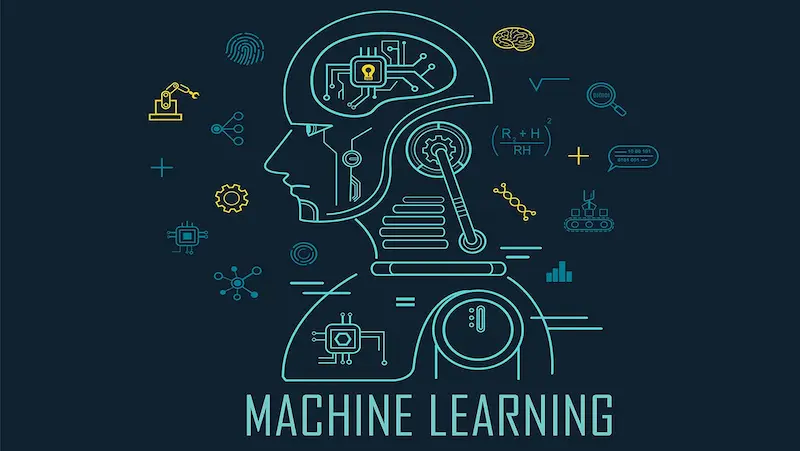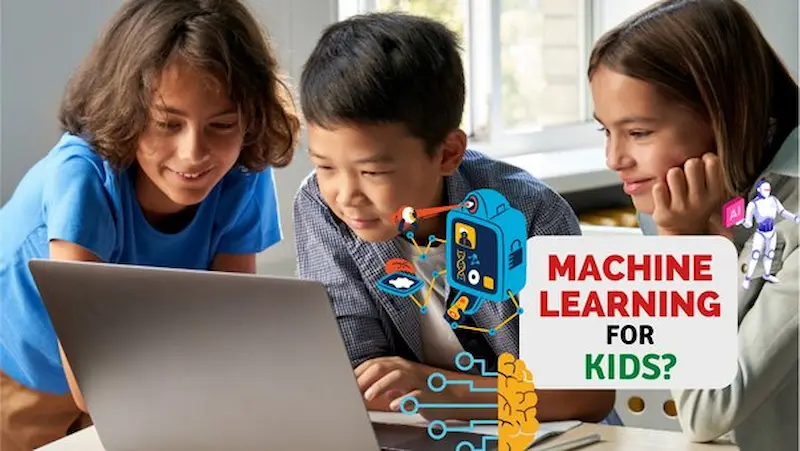In today’s fast-paced digital world, machine learning has emerged as a powerful and transformative technology. It has the potential to revolutionize various industries, from healthcare to finance, and even influence our daily lives.
As society becomes increasingly reliant on machine learning algorithms, it becomes imperative to prepare the younger generation for this technology-driven future. This is where machine learning education for kids plays a crucial role.
Machine learning education introduces children to the fundamental concepts and principles behind this cutting-edge technology. It empowers them with the knowledge and skills necessary to understand how machines can learn from data, make predictions, and automate tasks.
By fostering a deep understanding of machine learning, kids gain the ability to leverage this technology effectively and responsibly.
One of the key reasons why machine learning education is important for kids is its relevance in the job market of the future. As automation continues to reshape the workforce, the demand for professionals with expertise in machine learning and artificial intelligence is skyrocketing.
By starting early and gaining proficiency in these fields, children can position themselves for rewarding careers and become valuable contributors to the future economy.
Moreover, machine learning education cultivates critical thinking and problem-solving skills in children. It encourages them to think analytically, break down complex problems into manageable parts, and develop innovative solutions.
These skills are not only applicable in the realm of machine learning but also have broad implications across various disciplines. They equip children with the ability to tackle real-world challenges, adapt to rapidly changing environments, and thrive in the digital era.
From opening up exciting career opportunities to fostering critical thinking and data literacy, machine learning education sets the stage for a generation of digitally literate individuals who can shape a brighter future for all.
So,robotics for kids, coupled with machine learning, opens up a world of exciting career opportunities, paving the way for a brighter future for all. By nurturing their interest in these cutting-edge technologies, we empower children to become the next generation of innovators and problem solvers.
Table of contents

In today’s rapidly evolving technological landscape, machine learning has emerged as a transformative field with the potential to shape various industries. From healthcare to finance, transportation to entertainment, machine learning is making significant strides in optimizing processes and improving outcomes.
Recognizing the potential of this field, introducing machine learning concepts early to students and learners can provide numerous benefits. In this blog, we will explore some of the advantages of early exposure to machine learning concepts.
Developing Critical Thinking and Problem-Solving Skills
Introducing machine learning concepts early encourages students to think critically and develop problem-solving skills. Machine learning involves training models to analyze data, identify patterns, and make predictions or decisions.
By engaging with machine learning concepts at a young age, students learn to break down complex problems into smaller, more manageable components and develop systematic approaches to finding solutions. These skills are highly transferable and can be applied to various aspects of life, education, and future careers.
Fostering Computational Thinking
Machine learning concepts inherently promote computational thinking, which is an essential skill in the digital age. Computational thinking involves approaching problems in a structured manner, emphasizing logic, algorithmic thinking, and abstraction. Computer programming for kids in machine learning provides an exciting pathway for young enthusiasts to explore the world of artificial intelligence, enabling them to develop algorithms and models that can process data and make intelligent decisions.
Early exposure to machine learning concepts helps students understand how algorithms work, how data is processed, and how to utilize computational resources effectively. By cultivating computational thinking skills, students gain a powerful toolset to tackle a wide range of challenges, even beyond the realm of machine learning.
Nurturing Creativity and Innovation
Machine learning offers vast opportunities for creativity and innovation. Early exposure to these concepts encourages students to explore unique ways of using machine learning algorithms to solve problems and generate novel ideas.
Students can experiment with different data sets, models, and techniques to create their own projects and explore real-world applications. By fostering creativity and innovation, educators can empower students to think outside the box and develop skills that will be invaluable in future careers and endeavors.
Building Data Literacy
In today’s data-driven world, understanding and interpreting data is becoming increasingly important. Introducing machine learning concepts early helps students develop data literacy skills. They learn to analyze and interpret data, identify biases, and make informed decisions based on data-driven insights.
Data literacy is crucial for making sense of the vast amounts of information available in the digital age, enabling individuals to become more discerning consumers and contributors to the modern information ecosystem.
Enhancing Career Opportunities
The demand for professionals with machine learning expertise is growing rapidly across industries. By introducing machine learning concepts early, educational institutions can prepare students for future career opportunities.
Early exposure provides a solid foundation and allows students to build upon their knowledge as they progress through higher education and beyond. Additionally, the ability to demonstrate proficiency in machine learning concepts at an early stage can significantly enhance a student’s resume and set them apart in the job market.
Enroll in robotics classes for kids to kickstart their promising career in the field of machine learning and robotics. By gaining hands-on experience and knowledge, they can enhance their job prospects and contribute to technological advancements
Understanding Machine Learning
Welcome, young curious minds! Today, we are going to embark on an exciting journey into the world of machine learning. Have you ever wondered how computers can learn just like humans do? Well, that’s what machine learning is all about. So, fasten your seatbelts and let’s dive in!

What is Machine Learning?
Machine learning is a special way of teaching computers to learn and make decisions on their own, just like how we humans learn from our experiences. It’s like having a smart friend who can observe things, learn from them, and make decisions based on what it has learned.
Imagine you have a dog named Max. When Max was a little puppy, you had to teach him commands like “sit” or “fetch.” But as Max grows up, he starts to learn on his own. Machine learning works in a similar way. Instead of writing every single command, we help computers learn and improve by themselves.
Basic Concepts:
Data: Data is like information that computers use to learn. It can be numbers, pictures, sounds, or anything that helps computers understand things. Just like you use books or videos to learn, computers use data to learn.
Training: Training is the process of teaching computers to learn from the data. It’s like practicing with Max to teach him tricks. In machine learning, we show the computer lots of examples and help it understand what’s important.
Algorithms: Algorithms are like sets of instructions or rules that computers follow to learn from the data. They are like recipes that tell the computer what to do with the data it sees. Different algorithms can do different things, just like different recipes make different dishes.
Models: Models are what computers create after they have learned from the data. Think of it as a puzzle that the computer solves. Once it solves the puzzle, it can use the model to make predictions or decisions.
Terminology Explained:
Prediction: When computers use what they’ve learned to guess or estimate something, it’s called a prediction. For example, based on the training it received, a machine learning model can predict whether a picture shows a dog or a cat.
Accuracy: Accuracy tells us how good the computer is at making correct predictions. If the computer is very accurate, it means it’s making mostly correct guesses. It’s like when you play a game, and the more you practice, the better you get at winning.
Feedback: Just like we learn from feedback, computers also need feedback to improve. If a computer makes a wrong prediction, we can give it feedback to help it correct its mistakes. This feedback is used to train the computer better, just like when someone tells you how to improve your drawing.
Automation: Automation means getting a computer to do things automatically without human intervention. With machine learning, we can train computers to do tasks automatically, like recognizing faces in pictures or translating languages.
Getting Started with Machine Learning for Kids
In today’s technology-driven world, machine learning is becoming increasingly important. It is a powerful tool that can help us solve complex problems and make sense of vast amounts of data. While machine learning may sound like a topic reserved for experts, it is never too early to introduce kids to the basics of this fascinating field. Robotics programming for kids in machine learning introduces young learners to the fascinating intersection of artificial intelligence and robotics, empowering them to build intelligent machines and understand how algorithms can enhance robotic capabilities.
Unlock Creativity and Logic with CodeChamps, Where Coding is the Key to Turning Ideas into Digital Masterpieces!
By nurturing their curiosity and providing them with the right resources, we can lay the foundation for a future generation of innovative thinkers. In this blog post, we will explore the suitable age range for learning machine learning and discuss the prerequisite knowledge and skills needed to get started.

Suitable Age Range for Learning Machine Learning:
Machine learning concepts can be introduced to children as young as 10 years old, depending on their level of interest and understanding. While the exact age may vary from child to child, it is generally recommended to start teaching machine learning to kids around the ages of 10 to 12.
At this stage, children typically possess the cognitive abilities to grasp basic programming concepts and understand the underlying logic of machine learning algorithms. However, it’s important to note that older kids and teenagers can also benefit from learning machine learning, especially if they have prior experience in programming or mathematics.
Building a Foundation: Prerequisite Knowledge and Skills:
Before diving into machine learning, kids should have a solid foundation in a few key areas. These prerequisites will help them better comprehend the concepts and apply them effectively:
Basic Programming Knowledge:
Familiarity with programming fundamentals is crucial for understanding machine learning. Kids should have some experience with a programming language like Python, which is widely used in machine learning.
They should understand concepts such as variables, loops, conditionals, and functions. Online platforms like Code.org, Scratch, or interactive tutorials specifically designed for kids can provide an excellent starting point to learn programming.
Mathematics:
While advanced mathematical knowledge is not mandatory for beginners, a basic understanding of concepts like arithmetic, algebra, and statistics is beneficial. Kids should be comfortable with concepts like addition, subtraction, multiplication, division, equations, and averages.
As they progress, concepts such as probability, graphs, and data visualization will also become essential.
Logical Reasoning and Problem-Solving:
Machine learning involves analyzing data, identifying patterns, and solving problems. Encouraging kids to think critically, reason logically, and solve puzzles will help develop the necessary skills for machine learning.
Engaging them in activities that promote problem-solving, such as puzzles, brain teasers, and coding challenges, can sharpen their analytical thinking abilities.
Data Literacy:
Teaching kids about data and its importance is a crucial aspect of machine learning. Explain the concept of data, its various types (text, images, numbers), and how it can be collected and organized.
Familiarize them with simple spreadsheets or data visualization tools to showcase the power of data representation. Additionally, teach them the importance of privacy, ethics, and responsible use of data.
Resources for Kids Learning Machine Learning:
To get started with machine learning, several resources cater specifically to kids’ learning needs. Here are a few recommendations:
Machine Learning for Kids: This online platform provides a friendly interface for children to experiment with machine learning models. It offers interactive tutorials, project ideas, and a visual programming environment suitable for young learners.
Educational Games and Apps: Numerous educational games and apps focus on teaching programming and machine learning concepts to kids. Examples include CodeCombat, Kodable, and Scratch, which provide an interactive and playful learning experience.
Books and Online Courses: Various books and online courses tailored for kids cover introductory concepts of programming and machine learning. Examples include “Hello Ruby: Adventures in Coding” by Linda Liukas and “Python for Kids” by Jason R. Briggs. Websites like Khan Academy and Coursera also offer courses suitable for young learners.
Teaching Machine Learning to Kids
In today’s digital age, machine learning has emerged as a powerful tool that is shaping various industries and aspects of our lives. As educators and parents, it is crucial to equip children with the fundamental knowledge and skills needed to understand and harness the potential of machine learning. Coding classes for kids in machine learning provide a valuable opportunity for young learners to delve into the cutting-edge field of artificial intelligence and develop essential programming skills for the future.
By introducing kids to the basics of machine learning, we can encourage their curiosity, critical thinking, and problem-solving abilities. In this blog, we will explore some approaches and strategies for teaching machine learning to kids in a fun and engaging manner.

Start with the Basics:
To effectively teach machine learning to kids, it is essential to lay a solid foundation by introducing them to basic concepts and terminology. Begin by explaining what machine learning is and how it differs from traditional programming.
Use simple language and relatable examples to illustrate key concepts such as data, algorithms, and predictions. Encourage questions and provide ample opportunities for hands-on exploration. Also, Financial education for kids combined with machine learning offers a powerful combination, as young learners can utilize data-driven insights to understand money management and make informed decisions for their financial future.
Hands-On Activities and Projects:
Children learn best through hands-on experiences. Incorporate interactive activities and projects to engage their interest and foster a deeper understanding of machine learning.
Here are a few ideas:
a. Classification Game: Create a game where kids sort objects into different categories based on their attributes. This helps them grasp the concept of classification algorithms.
b. Predictive Modeling: Have students collect data, such as daily weather conditions, and teach them how to use it to predict future outcomes. This introduces the concept of predictive modeling and reinforces the importance of data analysis.
c. Image Recognition: Use visual recognition tools or apps to demonstrate how machines can learn to recognize and classify objects in images. Encourage kids to build their own simple image recognition models using platforms like Scratch or TensorFlow.
Real-World Applications:
Make connections between machine learning and real-world applications that are relevant to kids’ lives. Discuss how machine learning is used in recommender systems, voice assistants, facial recognition, and other technologies they interact with regularly.
This helps them understand the practical implications of machine learning and sparks their curiosity to explore further.
Collaborative Learning:
Promote collaborative learning environments where children can work together, share ideas, and solve problems as a team. Assign group projects that require students to collaborate on data collection, analysis, and model-building tasks.
Encourage them to present their findings and explain their models to their peers, fostering communication and critical thinking skills.
Ethical and Responsible AI Use:
As part of teaching machine learning, emphasize the importance of ethical considerations and responsible use of AI technologies. Discuss topics such as privacy, bias in algorithms, and the ethical implications of automated decision-making.
Encourage students to think critically about these issues and develop a sense of responsibility toward the ethical use of machine learning tools.
Gamification and Visualization:
Integrate gamification elements and visualization tools to make learning machine learning more enjoyable and accessible. Use platforms like Code.org, Scratch, or Blockly to introduce coding concepts in a playful manner.
Visualize data and model outputs using graphs, charts, or interactive visualizations to help kids understand the patterns and outcomes of machine learning algorithms.
Exploring Machine Learning Concepts
Machine Learning (ML) is a powerful field of study that empowers computers to learn from data and make intelligent decisions without explicit programming. As the demand for ML expertise continues to grow, it’s crucial for aspiring data scientists and enthusiasts to get their hands dirty with hands-on learning. Kids coding languages in machine learning, such as Scratch and Python, offer young enthusiasts a stepping stone to understanding the foundations of AI and creating their intelligent projects.
In this blog, we will embark on an exciting journey of creating simple machine learning models, providing a solid foundation for understanding key concepts and techniques.

Understanding Machine Learning:
Before diving into the practical aspects, let’s briefly discuss the fundamental concepts of machine learning. ML can be categorized into three main types: supervised learning, unsupervised learning, and reinforcement learning.
Supervised learning involves training a model on labeled data to make predictions or classify new instances. Unsupervised learning deals with uncovering hidden patterns and structures in unlabeled data. Reinforcement learning focuses on teaching agents to take actions in an environment to maximize rewards.
Python and Machine Learning Libraries:
Python is a popular programming language in the ML community due to its simplicity and extensive library support. Two essential libraries for ML are NumPy and Pandas, providing powerful tools for numerical computing and data manipulation, respectively. Python for kids is an accessible and widely used programming language that serves as an excellent entry point for young learners to explore the exciting world of machine learning and artificial intelligence
Additionally, libraries like scikit-learn, TensorFlow, and Keras offer a wide range of algorithms and tools for building ML models.
Data Preparation:
Data preprocessing is a crucial step in ML. It involves cleaning, transforming, and organizing data to make it suitable for training models. Common tasks include handling missing values, feature scaling, encoding categorical variables, and splitting data into training and testing sets. We will explore these techniques and their implementation using Python and Pandas.
Supervised Learning:
a. Regression: Linear regression is a simple yet powerful technique for predicting continuous values. We will create a basic linear regression model using scikit-learn and train it on a dataset to predict house prices based on various features.
b. Classification: Logistic regression is a commonly used algorithm for binary classification problems. We will build a logistic regression model to classify whether a customer will churn or not based on customer data.
Unsupervised Learning:
Clustering is an unsupervised learning technique used to identify natural groupings in data. We will utilize the K-means algorithm to cluster a dataset into distinct groups based on similar characteristics. This will enable us to gain insights into the underlying patterns and structures.
Evaluation and Model Selection:
Once we have trained our models, it’s essential to evaluate their performance and select the best one for deployment. We will explore evaluation metrics such as accuracy, precision, recall, and F1 score. Additionally, we will employ techniques like cross-validation and hyperparameter tuning to improve model performance.
Beyond Basics:
To further expand your knowledge, consider exploring other ML concepts such as decision trees, random forests, support vector machines, neural networks, and deep learning. These advanced techniques can handle complex problems and provide state-of-the-art results.
You can also delve into natural language processing, computer vision, and reinforcement learning to broaden your understanding.
Machine Learning Resources for Kids
In today’s digital era, where technology plays a significant role in our lives, introducing kids to concepts like machine learning can have a profound impact on their education and future careers. Machine learning, a branch of artificial intelligence, involves developing algorithms and models that allow computers to learn from data and make predictions or decisions.
By engaging children in interactive and entertaining activities centered around machine learning, we can ignite their curiosity, enhance critical thinking skills, and foster a passion for STEM subjects. In this blog, we will explore some exciting educational games and apps that introduce machine learning concepts to kids in a fun and accessible manner.

CodeMonkey:
CodeMonkey is an engaging platform that combines programming with machine learning principles. Kids solve coding challenges by guiding a monkey through various levels, collecting bananas along the way.
As they progress, they learn how to use machine learning techniques, such as decision trees and neural networks, to train their monkey to make intelligent choices. The game’s interactive nature and colorful visuals make it an excellent resource for introducing machine learning to young learners.
Machine Learning for Kids:
Machine Learning for Kids is an online platform specifically designed to introduce machine learning concepts to children. It offers a range of interactive activities and games that enable kids to build and train their machine learning models.
The platform provides a user-friendly interface where kids can work with pre-built machine learning models or create their own using Scratch, a popular visual programming language. Machine Learning for Kids empowers children to explore the exciting world of AI and develop their problem-solving and computational thinking skills.
Algobrix:
Algobrix is an educational game that combines coding, robotics, and machine learning. With Algobrix, kids can build physical robots and program them using blocks. The game teaches them the basics of coding and logical thinking.
It also includes machine learning elements, allowing children to train their robots to perform specific tasks or respond to stimuli. Algobrix provides a hands-on learning experience that merges the virtual and physical worlds, making it an excellent choice for young learners interested in robotics and AI.
robotics for kids is an exciting and educational field that combines creativity and STEM concepts, inspiring young minds to explore the wonders of technology and engineering.
Tynker:
Tynker is a popular platform that offers coding lessons and interactive games for kids of all ages. It includes a range of courses focused on machine learning and artificial intelligence.
Children can learn about concepts like image recognition, chatbots, and more through guided projects and coding challenges. Tynker’s visual programming interface and creative game-based approach make it an ideal resource for introducing machine learning to kids in a fun and accessible way.
Google AI Experiments:
Google AI Experiments is a collection of interactive projects that showcase the possibilities of machine learning and artificial intelligence. While not exclusively designed for kids, many of the experiments are engaging and educational for young learners.
Kids can explore projects like “Teachable Machine,” where they can train a model to recognize and respond to specific gestures or objects. These experiments provide a hands-on experience and encourage children to think critically about the capabilities of machine learning.
Conclusion
In conclusion, encouraging parents to support their child’s machine learning journey is crucial for nurturing their potential and preparing them for the future. Machine learning is an increasingly important field that has the potential to revolutionize numerous industries.
By providing support and resources, parents can help their children explore this exciting domain and unlock their creative and problem-solving abilities.
Firstly, supporting a child’s machine learning journey instills a love for learning and encourages curiosity. Machine learning involves experimentation, critical thinking, and problem-solving, which are essential skills for success in the digital age.
By fostering an environment where children feel supported and encouraged to explore machine learning concepts, parents can ignite their passion for learning and empower them to become lifelong learners.
Secondly, supporting children in machine learning nurtures their technological literacy and prepares them for future career opportunities. As technology continues to advance at a rapid pace, understanding machine learning concepts and applications will be invaluable in various fields.
By introducing children to machine learning early on, parents can help them develop the skills necessary to thrive in a technology-driven world and open doors to exciting career prospects. Robotics kits for kids in machine learning provide hands-on experiences that combine coding and building, allowing young learners to understand the principles of AI and create their intelligent robots and devices.
Finally, supporting children in their machine learning journey strengthens the parent-child bond and fosters a deeper understanding of their interests. By actively engaging in their child’s learning process, parents can demonstrate their support, build trust, and establish a collaborative relationship.
This involvement also provides an opportunity for parents to learn alongside their children, gain insights into their aspirations, and create meaningful connections through shared experiences.
In conclusion, by encouraging parents to support their child’s machine learning journey, we enable children to develop crucial skills, prepare for the future, foster creativity, and strengthen the parent-child bond.
Also programming for kids, starting with basic concepts and Python programming , lays the foundation for their intellectual growth and development. At BrightChamps, we offer interactive courses that nurture their coding skills, preparing them for a future filled with endless possibilities in the world of technology.
As we continue to embrace the potential of machine learning, it is essential to empower the next generation to explore and shape this transformative field. With the guidance and encouragement of parents, children can embark on an exciting journey of discovery, innovation, and personal growth that will serve them well in the digital age and beyond.
Unlock the doors to a brighter future for your child with BrightChamps. Our innovative edutech company offers a rich spectrum of learning experiences, from robotics to financial education and coding courses designed for kids.
Frequently Asked Questions
A1: Machine learning is a field of artificial intelligence where computers learn and make predictions from data. It’s important for kids because it encourages critical thinking, problem-solving, and understanding of how technology works.
A2: Children can start learning machine learning concepts as early as middle school, around 11 or 12 years old, depending on their interest and level of understanding.
A3: You can introduce machine learning concepts to your child through hands-on activities, interactive tutorials, and visual explanations to make it more engaging and understandable for them.
A4: Yes, there are online resources and platforms like Code.org, Scratch, and Google’s Machine Learning for Kids that offer kid-friendly materials and tools for learning machine learning.
A5: Engaging activities can include creating simple chatbots, training image recognition models, or building recommendation systems using familiar topics or datasets that interest the child.
A6: Coding skills are beneficial but not always necessary for learning machine learning at a beginner level. Some platforms offer visual programming interfaces or drag-and-drop tools to simplify the learning process.
A7: Machine learning skills can open doors to various career opportunities in fields like technology, data science, and artificial intelligence, providing your child with valuable skills for the future job market.

 We are an army of educators and passionate learners from BrightChamps family, committed to providing free learning resources to kids, parents & students.
We are an army of educators and passionate learners from BrightChamps family, committed to providing free learning resources to kids, parents & students.














